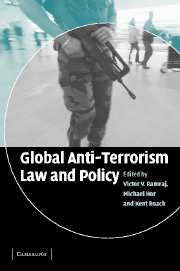Book contents
- Frontmatter
- Contents
- List of contributors
- Acknowledgements
- 1 Introduction
- PART ONE Theoretical Perspectives on Anti-Terrorism Law and Policy
- PART TWO A Comparative Study of Anti-Terrorism Measures
- PART THREE Anti-Terrorism Law and Policy in Asia
- PART FOUR Regional Cooperation
- PART FIVE Anti-Terrorism Law and Policy in the West
- 21 Legislative over-breadth, democratic failure and the judicial response: fundamental rights and the UK's anti-terrorist legal policy
- 22 United States responses to September 11
- 23 Canada's response to terrorism
- 24 The rule of law and the regulation of terrorism in Australia and New Zealand
- PART SIX Anti-Terrorism Measures in Africa, the Middle East and Argentina
- Index
24 - The rule of law and the regulation of terrorism in Australia and New Zealand
Published online by Cambridge University Press: 21 July 2009
- Frontmatter
- Contents
- List of contributors
- Acknowledgements
- 1 Introduction
- PART ONE Theoretical Perspectives on Anti-Terrorism Law and Policy
- PART TWO A Comparative Study of Anti-Terrorism Measures
- PART THREE Anti-Terrorism Law and Policy in Asia
- PART FOUR Regional Cooperation
- PART FIVE Anti-Terrorism Law and Policy in the West
- 21 Legislative over-breadth, democratic failure and the judicial response: fundamental rights and the UK's anti-terrorist legal policy
- 22 United States responses to September 11
- 23 Canada's response to terrorism
- 24 The rule of law and the regulation of terrorism in Australia and New Zealand
- PART SIX Anti-Terrorism Measures in Africa, the Middle East and Argentina
- Index
Summary
Introduction
Australia and New Zealand might seem unlikely targets for a terrorist attack. They are geographically isolated and are only minor players in the ‘War on Terror’. Nevertheless, Australia is an active military partner in the ‘Coalition of the Willing’ that went to war in Iraq in 2003 and both nations supplied troops for the conflict in Afghanistan. Australia has also come to the attention of terrorist organizations, with a recent statement purporting to be from al Qaeda declaring Australian Prime Minister John Howard to be ‘wicked’. Howard responded: ‘I've been insulted by everybody, so I suppose Al Qaeda can have a go as well.’
Although there has not been a terrorist attack for more than a decade on Australian or New Zealand soil, both have been affected by terrorism. Many New Zealanders regard the 1985 sinking in Auckland Harbour of the Rainbow Warrior by French agents, with loss of one life, as an example of state sponsored terrorism. More recently, Australians and New Zealanders died in the September 11 attack. A year later, on 12 October 2002, 202 people were killed when two bombs exploded in the Sari Club and Paddy's Bar in Bali, Indonesia. Of the dead, 88 were Australian and 3 were from New Zealand.
- Type
- Chapter
- Information
- Global Anti-Terrorism Law and Policy , pp. 534 - 552Publisher: Cambridge University PressPrint publication year: 2005
- 1
- Cited by



